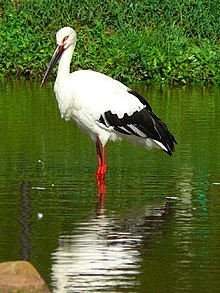Oriental stork
| Oriental stork | |
|---|---|

| |
| Scientific classification | |
| Domain: | Eukaryota |
| Kingdom: | Animalia |
| Phylum: | Chordata |
| Class: | Aves |
| Order: | Ciconiiformes |
| Family: | Ciconiidae |
| Genus: | Ciconia |
| Species: | C. boyciana
|
| Binomial name | |
| Ciconia boyciana R. Swinhoe, 1873
| |
| Distribution map of Oriental stork Yellow: breeding Blue: non breeding | |
The Oriental stork (Ciconia boyciana; traditional Chinese: 東方白鸛; simplified Chinese: 东方白鹳; pinyin: dōngfāng bái guàn; Japanese: コウノトリ Konotori[3]) is a large, white bird with black-feathered wings in the stork family Ciconiidae.
Taxonomy
[edit]The species was first described by Robert Swinhoe in 1873. It is closely related to and resembles the European white stork (C. ciconia), of which it was formerly often treated as a subspecies.
Description
[edit]It is typically larger than the white stork, at 100–129 cm (39.5–51 in) long, 110–150 cm (43–59 in) tall, a weight of 2.8–5.9 kg (6.2–13.0 lb) and a wingspan of 2.22 m (7.3 ft).[4][5] Unlike its more widespread cousin, the Oriental stork has red skin around its eye, with a whitish iris and black bill. Both sexes are similar. The female is slightly smaller than the male. The young are white with orange bills.
Distribution and habitat
[edit]The Oriental stork is found in Japan, China, Korea and Siberia. It was once extirpated from Japan and the Korean Peninsula. However, in May 2007 a hatchling was reported in Japan for the first time in 40 years in the wild. It was an offspring of two storks who were bred in captivity.[6]
Conservation
[edit]Due to habitat loss and overhunting, the Oriental stork is classified as endangered on the IUCN Red List of Threatened Species.[1] It is listed on Appendix I of CITES. There have been efforts to reintroduce the storks to the wild, but there must be changes to the environment first.[7] The storks were harshly impacted by the growth of the rice industry and the subsequent use of pesticides.[8][9] There is a push for rice farmers to grow their plants organically so that the storks may breed and grow safely in their environments.[10]
Diet and behaviour
[edit]The Oriental stork is a solitary bird except during the breeding season. It likes to wade in marshes, pond's edges, coastal beaches, and other wetlands. These birds are apex predator in their habitat. Its diet consists mainly of fish, frog, insects, small birds and reptiles, as well as rodents.[11]
Breeding
[edit]The female usually lays between two and six eggs. After breeding, the storks migrate to eastern China in September and return in March.[1][12]
See also
[edit]References
[edit]- ^ a b c BirdLife International (2018). "Ciconia boyciana". IUCN Red List of Threatened Species. 2018: e.T22697695A131942061. doi:10.2305/IUCN.UK.2018-2.RLTS.T22697695A131942061.en. Retrieved 11 November 2021.
- ^ "Appendices | CITES". cites.org. Retrieved 2022-01-14.
- ^ "Inter-institutional Panel on Population Management of the Oriental White Stork". ippm-ows.jp. Retrieved 2022-04-13.
- ^ Hancock & Kushan, Storks, Ibises and Spoonbills of the World. Princeton University Press (1992), ISBN 978-0-12-322730-0
- ^ CRC Handbook of Avian Body Masses by John B. Dunning Jr. (Editor). CRC Press (1992), ISBN 978-0-8493-4258-5
- ^ Endangered white storks hatch egg, Steve Jackson, BBC News, 20 May 2007.
- ^ "Sustaining Agrarian Futures | Anthropology-News". www.anthropology-news.org. Retrieved 2018-07-18.
- ^ Tatlow, Didi Kirsten (23 November 2012). "Endangered and Targeted: Fight to Save Oriental Stork Captivates China". IHT Rendezvous. Retrieved 2018-07-18.
- ^ "Japan looks to ancient wisdom to save biodiversity". Retrieved 2018-07-18.
- ^ "Reintroducing the oriental white stork in Toyooka City | Payments for ecosystem services (PES)". www.biodic.go.jp. Retrieved 2018-07-18.
- ^ Naito, Kazuaki, and Hiroshi Ikeda. "Habitat restoration for the reintroduction of oriental white storks." GLOBAL ENVIRONMENTAL RESEARCH-ENGLISH EDITION- 11.2 (2007): 217.
- ^ "Oriental Stork (Ciconia boyciana) - BirdLife species factsheet". datazone.birdlife.org. Retrieved 2018-07-18.

